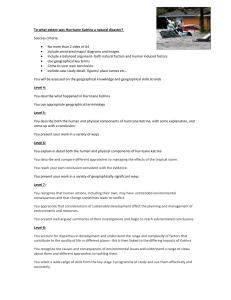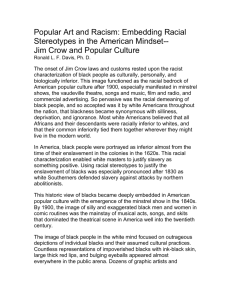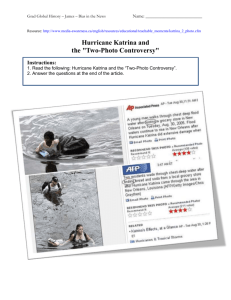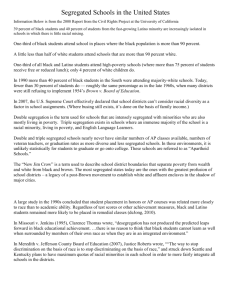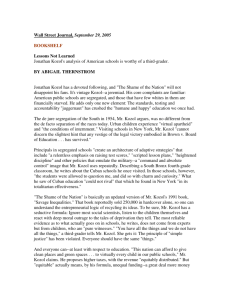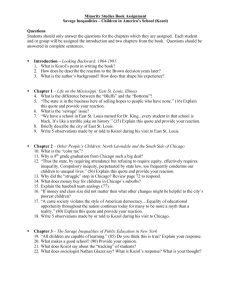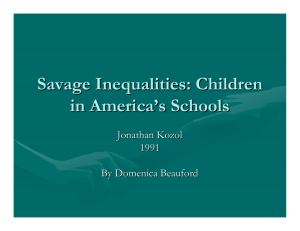Erika Batista December 8, 2010 Liberal and Civic Studies 121
advertisement
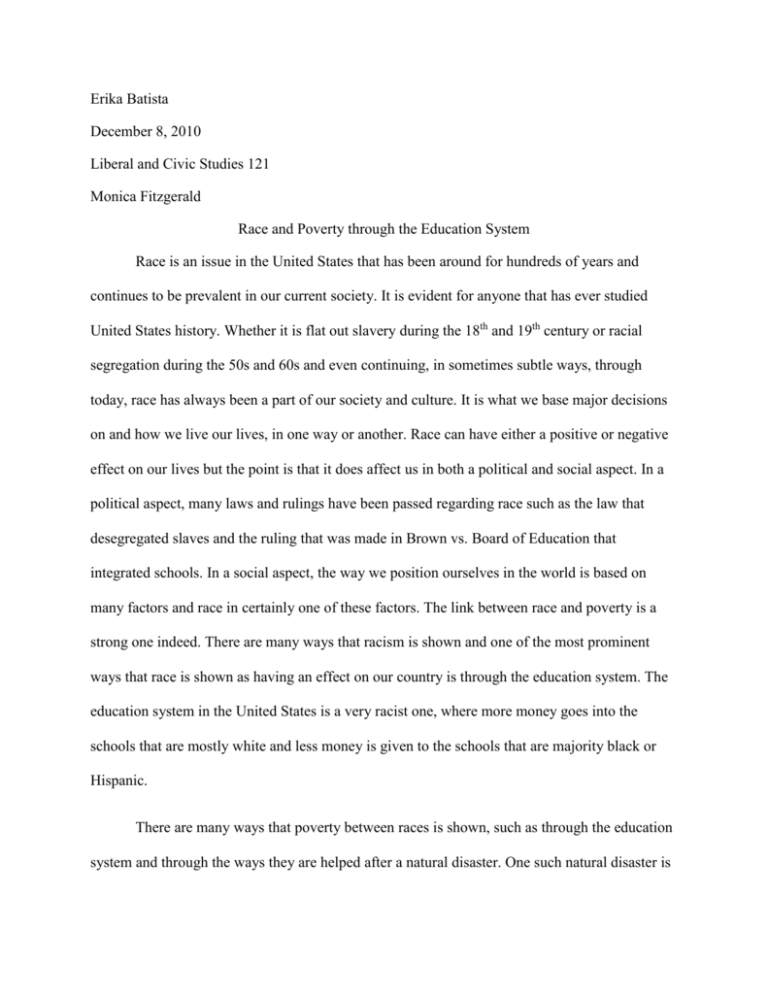
Erika Batista December 8, 2010 Liberal and Civic Studies 121 Monica Fitzgerald Race and Poverty through the Education System Race is an issue in the United States that has been around for hundreds of years and continues to be prevalent in our current society. It is evident for anyone that has ever studied United States history. Whether it is flat out slavery during the 18th and 19th century or racial segregation during the 50s and 60s and even continuing, in sometimes subtle ways, through today, race has always been a part of our society and culture. It is what we base major decisions on and how we live our lives, in one way or another. Race can have either a positive or negative effect on our lives but the point is that it does affect us in both a political and social aspect. In a political aspect, many laws and rulings have been passed regarding race such as the law that desegregated slaves and the ruling that was made in Brown vs. Board of Education that integrated schools. In a social aspect, the way we position ourselves in the world is based on many factors and race in certainly one of these factors. The link between race and poverty is a strong one indeed. There are many ways that racism is shown and one of the most prominent ways that race is shown as having an effect on our country is through the education system. The education system in the United States is a very racist one, where more money goes into the schools that are mostly white and less money is given to the schools that are majority black or Hispanic. There are many ways that poverty between races is shown, such as through the education system and through the ways they are helped after a natural disaster. One such natural disaster is Hurricane Katrina. Hurricane Katrina is a good example in Unites States history of how race plays a big factor in determining the possible outcome of someone’s future. In the aftermath of Hurricane Katrina, “blacks outside the city were 1.5 times more likely than similar whites to evacuate after, rather than before, the storm” (Elliott). Why were blacks not evacuated before the storm? Why did something tragic have to happen before something drastic was done? This is not how it should be but unfortunately it is. The way that blacks are portrayed during such natural disasters is completely different than the way whites are portrayed. There are two pictures depicting the same image however in one picture, the person is black and in the other the people are white. The caption under the first picture is “A young man walks through chest-deep flood water after looting a grocery store in New Orleans” and the caption under the second picture is “Two residents wade through chest-deep waters after finding bread and soda from a local grocery store after Hurricane Katrina came through the area” (Harris and Carbado 423). Looting versus finding. It might not seem like a slight word change between the pictures could make that big of a difference but it does. “Looting” gives the negative impression that the young man stole the product from a grocery store that he went in to. “Finding” gives the neutral impression that the two people simply came across these items while they happen to float by the grocery store. This image of blacks being “criminals” has been around for as long as slavery and it is an image that is difficult to get rid of. Many people who believe this will not hire black people to work for them, meaning that they will not get a job and therefore go into poverty. Did the photographer of these pictures mean to display blacks as criminals and whites as just being lucky? Well that is the impression he is giving to half the world who reads these articles. Even if he did not purposely try to racially discriminate against blacks he subconsciously did it which in my opinion is even scarier. To think that could come up with something like this without even thinking about it just shows how the United States has taught us to think about people of color. “Not all racial bias is blatant however. Indeed, much of the research in recent years indicating the persistence of white racial biases has been in the area of implicit, often subconscious prejudice, which, however subtle, can still contribute to unequal treatment of people of color in given situations” (Wise 81). This idea of subtle racism is engrained many people and accounts for why racism is still alive and active in the United States. Since the racism is subtle, it is difficult for people to see that they are even being racist and without even thinking about it will do something that can be seen as racist, such as denying someone a job because of their skin color. This constant denying of jobs either leads people into poverty or keeps them there if there are already in poverty. People have been separating themselves from each other since the English came over and separated themselves from the Native Americans. This separation has been occurring for hundreds of years and it is hard to break a habit. The schools in the United States are segregated as much as Americans do not want to believe it and even after Brown vs. Board of Education that stated that schools were required to be integrated. As much as Americans want to believe that we are not a racist society, Jonathan Kozol, author of The Shame of the Nation, argues a different point of view, “Schools that were already deeply segregated 25 or 30 years ago, like most of the schools I visited in the Bronx, are no less segregated now, while thousands of other schools that had been integrated either voluntarily or by the force of law have since been rapidly resegregating both in northern districts and in broad expanses of the South” (18). Schools become segregated because of the area that a certain race tends to live in. For example, people of color tend to live in the same area so their children are going to go to the same school, making that school mostly “colored”. The sad thing is, however, that these areas that people of color tend to live in are usually poorer areas, meaning that the schools that they send their kids to are not going to have as much money as they need in order to maintain a decent school. Simple things that most people expect out of schools such as the buildings being kept up to code or a decent education are not always what children in these poorer schools get. In a school in New York that Kozol talks about, has horrific conditions that make us wonder if children can actually learn in a place like that, “an entire frame of windows in out make-shift class collapses. I was standing close enough to catch the rotted frame before the glass could shatter on the children sitting just beneath it” (3). It is difficult enough to get through school when everything one needs is there but when the buildings are not even safe enough to learn in then it makes it not a safe or comfortable place to learn in. The lack of funding sends the message to these children that they are not even worth enough to have a decent building to learn in. Not only does the problem with buildings affect the children’s self-worth, it begins to affect their education directly. Sometimes classes in schools where the children are of color need to be cut because of the lack of resources they have, “The principle showed me gaping holes in several walls and said the basement was condemned for use ‘because of ventilation problems,’ so activities like music, which she valued highly, could not take place in the basement any longer” (167). Since there is not enough funding to fix the building, classes have to be cut; classes that are not core classes but allow the students to express their individuality. Most of the time, individuality are all these kids have and taking that away from them is simply cruel. Children need to learn to express their creativeness and if they cannot do it at school, then who knows what else they are going to do. Children of color are constantly faced with the negative stereotype that they are “adultified” or “willfully bad”. As Ann Ferguson wrote about in her book Bad Boys, “As black children’s behavior is refracted through the lens of these two cultural images, it is ‘adultified’. By this I mean their transgressions are made to take on a sinister, intentional, fully conscious tone that is stripped of any element of childish naiveté” (83). This is different from the way that white boys are seen. They are seen as “naturally naughty” meaning that for white boys, misbehaving or acting out is seen as a phase that they are going to grow out of. This image of the two different races is a contributing factor to the fact that schools in mostly black neighborhoods do not get the resources they need in order to succeed. If schools are not given the necessary supplies they need, then how can we expect the students to learn and grow through school? The answer is we cannot. This fact is so prominent that even then students in the school know what is going on and begin to blame themselves, “Many of the students blamed themselves for problems in the school” (Kozol 184). When students begin to blame themselves then their sense of self-esteem goes down which discourages them from wanting to move on and possibly move up and out of their current situation. Children in these types of schools are not happy and therefore would not want to continue on with their education, “Segregated schools like Martin Luther King are often tense, disorderly, and socially unhappy places” (26). If children are not comfortable in their environment, why would they want to stay? They do not which is why the high school dropout rate for people of color is so much higher than white people. Because of their racial differences, children of color are even taught differently than white children. They are taught “soft skills” such as sewing and how to interview, “The teacher said the children also learned check-writing and were taught the way to do an interview…the way to read a want ad, and the way to write a resume” (156). Since people of color have been getting deficient education since a young age, they are taught for the test instead of being taught just to learn, “an imposing document called the ‘The Immediate Intervention Plan’…called for ‘five percent improvement’ in the student’s scores over a given period of time” (170). If this improvement is not met, this can cause some serious repercussions for the teachers and the principle of the school. In order to avoid any harm to their jobs, the teachers teach lowerperforming schools, mostly colored schools, material for the text instead of just simply teaching them. White schools that have a high performance rate are allowed to do more activities because they already score high enough on their tests. Also, when a school gives a high performance rate, they are allotted more money which means more and better resources are going toward the school which in turn means that the students are being taught more efficiently and effectively. There are some possible solutions to the problem at hand. One possible solution that was tried was busing students to different districts in order to integrate them more. This had mixed results but I think that this would not really work because just because the school itself is integrated does not mean that the students are going to respond well to the change. This solution solves the segregation issue but it does not change the minds of hundreds of high school students. Another possible solution to this problem is somehow finding the economic resources to be able to provide enough funds to school in lower income areas in order to provide the necessary supplies that these schools need. I realize that this is a very difficult task to accomplish but the biggest and most important issue is money and if we can somehow find the money to give then the education system would be better. I am not saying that this is the only solution because if the teachers that are teaching in the schools are good and effective then money should not be that big of an issue. America needs to start at the source and educate the teachers well enough so that they can go into schools and teach what they have learned to their students in a way that will stick with them and make them want to move forward in their education. The education system in America is rapidly declining, becoming more and more racist and segregated. It has been like this for years and it hard to change an entire country’s mind but with effective teachers in the school system, only good things can emerge. The biggest issue is and will always be money. Without the money to put into the schools, the resources will never be there for the students or the teachers. The education system is one that needs to be fixed and fast before we all go downhill. Works Cited Kozol, Jonathan. The Shame of the Nation: the Restoration of Apartheid Schooling in America. New York: Three Rivers, 2005. Print Wise, Tim J. Colorblind: the Rise of Post-racial Politics and the Retreat from Racial Equity. San Francisco: City Lights, 2010. Print. Colombo, Gary, Robert Cullen, and Bonnie Lisle. "Loot or Find:Fact of Frame?" Rereading America: Cultural Contexts for Critical Thinking and Writing. Boston, MA: Bedford/St. Martins, 2010. Print. "Ann Arnett Ferguson: Bad Boys, University of Michigan Press." The University of Michigan Press. Print. Elliott, James R. Race, Class, and HUrricane Katrina: Social Differences in Human Responses to Disaster. Web. <http://www.chssp.columbia.edu/events/documents/disasters_elliottandpais.pdf>.


